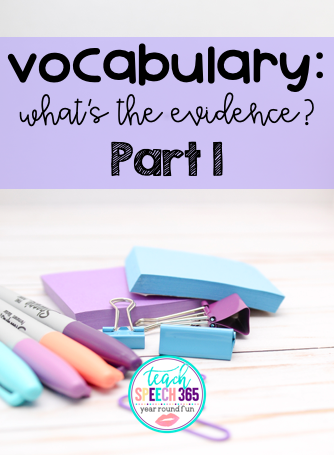Vocabulary: What’s the Evidence? Part 1

Vocabulary. It’s a HUGE area and one that can be overwhelming to think about in terms of using evidenced based therapy strategies. At least for me! Recently, ASHA put out an email with a ton of research articles centered around vocabulary and I immediately printed a bunch out and spent time reading them all. I decided to compile the research into a couple blog posts (this is Part 1, Part 2 is on its way later this month) to hopefully make it easier to digest for you all.
Tackling the area of vocabulary for intervention is tough because there are so many aspects of a word to consider “including features of its meaning, situations in which it is used, associations with other words, and how it behaves syntactically in context” (McKeown, 2019). Vocabulary is tied very closely to reading comprehension. As SLPs, we know the benefits of teaching Tier 2 words, that is those words that include a lot of academic vocabulary that a student needs to know in order to success in the general education curriculum.
Also of note is morphology. This is why some of us choose to teach root words, as they can help students to figure out the meaning of unknown words. As you know, it is impossible for us to teach every single word. Instead we have to teach strategies to help our students figure out what words mean when they encounter them.
So what constitutes effective instruction? It’s actually not just about teaching word meanings, but also teaching the students to understand how to use their knowledge of words during reading comprehension tasks. Reading is where they will likely encounter several words they may not know. How do we do this, though? One way McKeown suggests is to embed a new word in an easy activity, such as asking students “if they would be eager or reluctant to do something.” Then the teacher/SLP can talk about thinks like going bungee-jumping, trying a new food, being on stage in front of tons of people (McKeown provides examples of this strategy in the article). As clinicians, another strategy would be to start using “sophisticated words” while we’re talking and having the students try to “catch” you using a word they may not know. This can lead to further discussion about that word and extension activities can be built from that.
In another article, the author talks about how “word knowledge is multidimensional” (Duff, 2019). Words can have multiple meanings (I’m sure we all have students on our caseloads who are working on multiple meaning words). She also referenced an earlier study that vocabulary depth, rather than breadth, is important when it comes to reading comprehension.
Vocabulary is a tough area, especially for me as many of my students are also ESOL. They are trying to learn English as well as maintain their home language, which can make for some interesting challenges. Add in a language disorder, and I know that vocabulary is difficult for many of my students. This is why I’m always on the hunt to find what the latest research says about vocabulary development! Part 2 is coming soon!
Here are the citations for the two articles referenced throughout this blog post:
McKeown, M. G. (2019). Effective Vocabulary Instruction Fosters Knowing Words, Using Words, and Understanding How Words Work. Language, Speech, and Hearing Services in Schools, 50, 466–476. Retrieved from https://pubs.asha.org/doi/10.1044/2019_LSHSS-VOIA-18-0126
Duff, Dawna. (2019). Has Vocabulary Intervention Had an Effect? A Valid, Reliable, and (Fairly) Quick Outcome Measure for Semantic Knowledge. Language, Speech, and Hearing Services in Schools, 50, 506–517. Retrieved from https://doi.org/10.1044/2019_LSHSS-VOIA-18-0134
